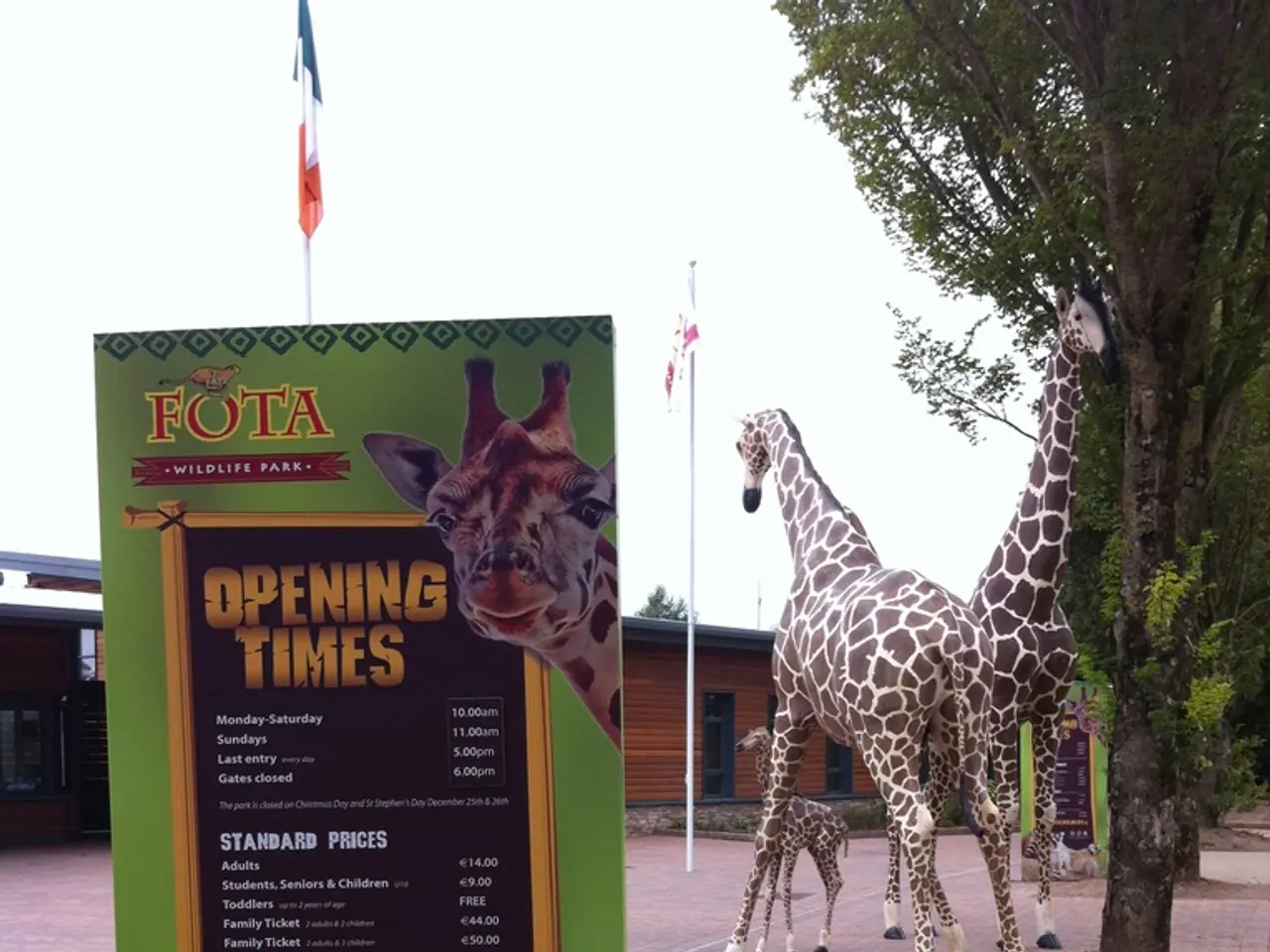"7 Zoological Parks Dedicated to Reintroducing Wildlife and Recovering Ecosystems"
Zoos Embrace Conservation: A Global Shift Towards Rewilding
In a remarkable transformation, the world's leading zoos are shifting their focus from exhibition to active conservation. This movement, aimed at rewilding animals and restoring habitats, is sweeping across the globe.
Take the San Diego Zoo, for instance, where scientists meticulously monitor the genetics and health of each California condor to ensure their survival. Their efforts have proven successful, with hundreds of condors reintroduced back into the wild, saving them from extinction.
Similarly, the San Diego Zoo works closely with local communities to protect nesting sites and reduce threats like lead poisoning for the California condors. This collaborative approach is a testament to the importance of partnerships in conservation efforts.
Across the Pacific, the Singapore Zoo provides artificial nest boxes and restores native vegetation to give the Oriental pied hornbills a fighting chance. Their efforts have resulted in the successful reintroduction of this species, which was once extinct locally due to habitat loss.
In Australia, Taronga Zoo is working on bringing back the Regent Honeyeater, an endangered bird species, through conservation programs. Every chick of the regent honeyeater is crucial due to their low population in the wild. Release sites for these birds are chosen based on restored woodlands and ample food sources.
Local volunteers play a significant role in these efforts, planting native flowers and helping to monitor nesting activity for the regent honeyeaters. Tiny transmitters are used to track these released birds, providing valuable data for ongoing conservation efforts.
The Durrell Wildlife Conservation Trust, based in the UK, has established secure breeding sites and a rigorous rewilding program for the ploughshare tortoise in Madagascar. This organisation is on a mission to save the ploughshare tortoise, a species that faces significant threats due to habitat loss and poaching.
Chester Zoo in the UK is also making a significant impact, restoring native habitats and reintroducing endangered species like the ploughshare tortoise and various lemur species in Madagascar. Their holistic approach includes planting native trees, educating villagers, and developing sustainable livelihoods to reduce pressure on Madagascar's forests.
The Bronx Zoo, operated by the Wildlife Conservation Society, has reintroduced American bison to the Great Plains, helping them recover from near extinction. This initiative has had a ripple effect, benefiting numerous other species in the prairie ecosystem.
Pairi Daiza, a zoo in Belgium, has rewilded European bison through careful breeding and collaboration with European rewilding networks.
Innovative technologies are also playing a crucial role in these rewilding efforts. Vantara Zoo in India, for example, has developed as a leading wildlife rescue and rewilding center that integrates advanced veterinary care with AI-driven monitoring systems. Their facilities include ICUs, MRI, CT scans, and physical therapy technologies. They use drones and smart sensors to optimize animal habitats and support rehabilitation before reintroducing animals to the wild.
Lincoln Park Zoo's innovative phenology research supports rewilding by monitoring plant growth cycles to better understand habitat changes due to climate. Their work facilitates urban habitat restoration and provides data contributing to national climate change models through community science projects.
These examples represent a trend in zoos moving beyond traditional captive care towards active roles in species recovery, habitat restoration, and leveraging modern technology for conservation and rewilding efforts worldwide. The future of conservation lies in these collaborative, innovative, and forward-thinking initiatives.
[1] Reintroduction of hamsters on the Tarutino Steppe: https://www.kyivzoo.ua/en/news/tarutino-steppe-hamster-reintroduction-project [2] Los Angeles Zoo’s reintroduction of Tasmanian devils: https://www.latimes.com/environment/story/2021-09-01/tasmanian-devils-los-angeles-zoo [3] Vantara Zoo in India’s development as a leading wildlife rescue and rewilding center: https://www.thehindu.com/sci-tech/technology/vantara-zoo-in-india-develops-ai-driven-wildlife-rescue-and-rehabilitation-system/article37379127.ece [4] Los Angeles Zoo’s reintroduction of Tasmanian devils (additional source): https://www.abc.net.au/news/2021-09-01/tasmanian-devils-arrive-in-los-angeles-zoo-for-breeding-program/100379250 [5] Lincoln Park Zoo’s innovative phenology research: https://www.lpzoo.org/conservation/phenology-research
- Wildlife research plays a significant role in rewilding efforts, such as the monitoring of hamster populations on the Tarutino Steppe by the Kyiv Zoo.
- San Diego Zoo's collaboration with scientists and local communities has led to the reintroduction of Tasmanian devils, showcasing the importance of partnerships in conservation projects.
- Innovative technologies are reshaping conservation and rewilding, as exemplified by Vantara Zoo in India, which integrates AI-driven monitoring systems and advanced veterinary care in its wildlife rescue and rewilding efforts.
- The development of secure breeding sites and rigorous rewilding programs for endangered species like the ploughshare tortoise falls under the scope of environmental-science organizations such as the Durrell Wildlife Conservation Trust.
- As part of coastal ecosystem conservation, the Singapore Zoo's restoration of native vegetation supports the reintroduction of the Oriental pied hornbill, demonstrating the importance of insects like pollinators in these ecosystems.
- Leveraging education-and-self-development platforms, zoos like the Lincoln Park Zoo foster innovation in phenology research, using community science projects to inform habitat restoration and contribute to national climate change models.




